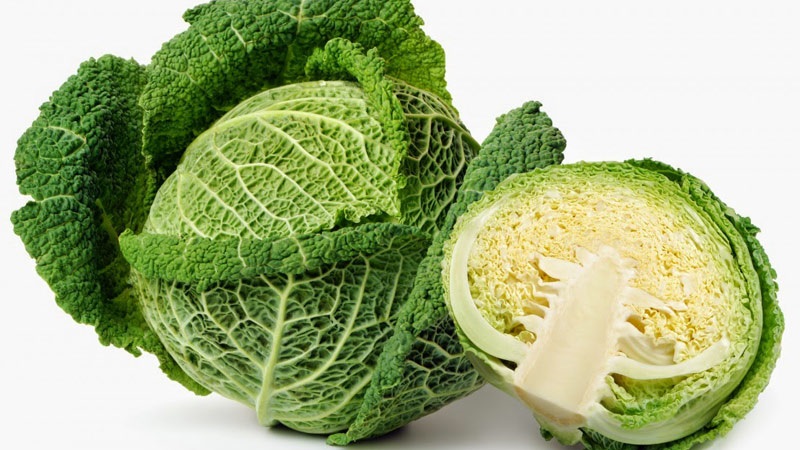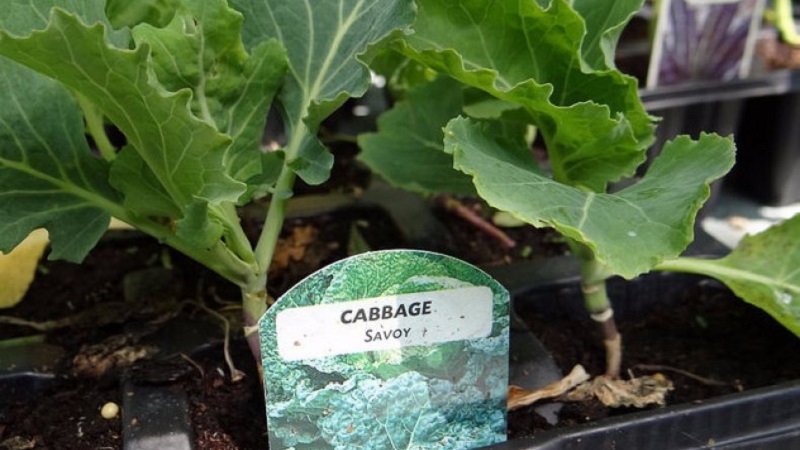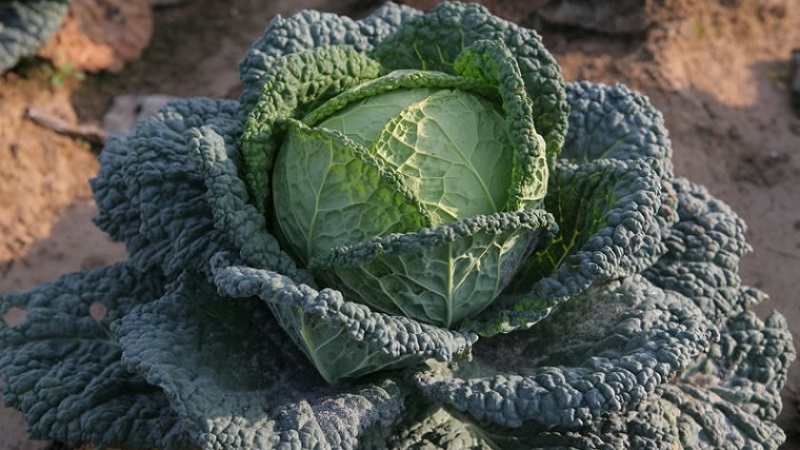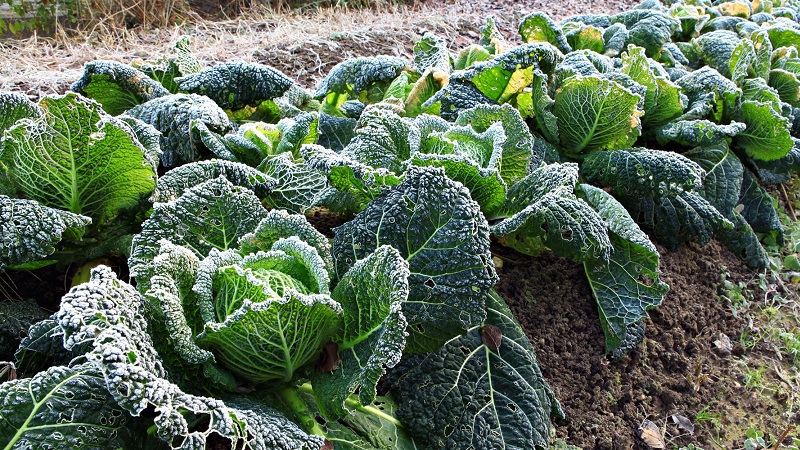Sowing and growing savoy cabbage
Savoy cabbage is not very popular with Russian vegetable growers. Many gardeners believe that it is capricious and not suitable for a harsh climate. However, cabbage does not require special care. It survives frosts better than white cabbage, is much softer and tastier, contains less mustard oils and fiber. Found in it, ascorbigen, splitting in the stomach, slows down the growth of cancerous tumors.
The content of the article
Which Savoy cabbage is best to plant
Savoy cabbage - a subspecies of Cabbage... The plant is characterized by corrugated thin leaves, color from pale green to dark emerald, pleasant and delicate taste. For the first time its edibility was found in North Africa and in the western Mediterranean. Later, in the Italian county of Savoy, cabbage began to be grown as a crop, and this place gave the vegetable its name. In Russia, the plant did not gain wide distribution due to unsuitability for fermentation, relatively low yield compared to white cabbage and the erroneous judgment that the crop is capricious and will not survive in the Russian climate.

Varieties and hybrids of savoy cabbage a lot is displayed, but for sowing in Russia the following are best suited:
- late-ripening: Alaska F1, Viratoba F1, Virosa F1, Jade F1, Nadia - heads of cabbage are hard, ripen for a long time and are well stored in winter (up to 6 months after harvest);
- mid-season: Vertyu 1340, Melissa F1, Mila F1, Ovasa F1, Sphere F1, Extrema F1 - large heads of cabbage, stored for up to 5 months, resistant to cracking;
- early ripe: Zolotaya early, Elena F1, Moscow lacemaker, Nyusha, Petrovna, Pirozhkovaya, Salima F1, Yubileinaya 2170 - they have a very delicate taste and flexible leaves, the harvest is stored for up to 3-4 months.
All of them adapted for cultivation in greenhouses and open field.
Interesting on the site:
Benefits and harms, features of the use of savoy cabbage
Growing savoy cabbage from seeds
Before germination, improve seed germination and protect them from certain diseases... The cultivation rules are almost the same as for white cabbage, but there are some nuances. It is important to carefully look after the seedlings, fertilize the soil, adhere to the temperature regime.
Soil preparation
To get a harvest at the beginning of June, they buy and plant seeds of early varieties and hybrids. They begin to grow seedlings in March, they are transferred to open ground from May 1 to 10.
Successful the harvest largely depends on the conditions in which the seedlings grow:
- plants are planted in separate containers so that the root system is properly formed;
- if planting in the ground under the film occurs in April, after 40 days the seedlings are transplanted to a permanent place;
- the optimum acidity of the soil is pH 5.6-7;
- the soil should be soft and not too loose: mix 80% peat, 20% turf, 5% sand and 5% humus, add 1 tbsp. l. wood ash.
The soil is pre-shed strong solution of potassium permanganate for disinfection.
Sowing seeds
The planting material is heated for 20 minutes in hot (+ 50 ° C) and cooled for 5 minutes in cold water... This increases the resistance of future plants to fungal diseases. Then the seeds are immersed for several hours in a solution of a growth stimulant - humate, "Epina", "Silka", etc.
Advice! Pre-study the instructions on the packaging with planting material. The seeds of some varieties cannot be soaked, in hybrids they are usually processed by the manufacturer, coated seeds do not require any preparation.
Phased planting of seeds:
- Place the seeds in 1 cm increments in the treated and moist soil, in the prepared grooves at 3 cm intervals.
- Bury them to a depth of 1 cm. Moisten with a spray bottle.
- Make a greenhouse of glass or film, in which a constant temperature of + 18 ° C will be maintained.
The first shoots are placed in a bright place.where the temperature is maintained at least + 8 ° C.

Seedling care
Well-grown seedlings are the key to a good harvest in the future... After the first shoots appear, they are thinned out, observing a distance of 2 cm. It is important not to deprive the seedlings of light, their daylight hours should be 14-15 hours. During the pick, a phytolamp or an ordinary fluorescent lamp is installed to compensate for the lack of light.
When the first shoots appear, the temperature in the room with seedlings should be at least + 18 ... + 20 ° C. When the sprouts get stronger, it is reduced to + 15 ... + 16 ° C during the day and + 8 ... + 11 ° C at night, otherwise they will stretch too far up. Water the plants as the topsoil dries out.
Important! If the plants were planted in a common container, when they have 5 leaves, they are dived into separate containers. Deepen to the cotyledons.
Thickened planting, stagnation of moisture in the soil, non-observance of temperature standards lead to the appearance of a black leg in plants, rotting of the root part of the stems.
After picking for feeding, use every 2 weeks a mixture of 2 g of ammonium nitrate, 4 g of potassium fertilizers and superphosphate and 1 liter of water. Previously, the earth is watered with water to avoid burns on the seedlings.
Plants are hardened 1-2 weeks before transplanting into open ground: taken out into the street, gradually increasing the time spent there from several hours to 1 day.
Landing at a permanent place
The place on the site for the culture should be well lit... The soil is suitable loamy, neutral or sandy loam.
The garden is prepared in the fall: the soil is dug deeply, the weeds are waited for and removed, and then again the soil is evenly distributed over the plot. In the spring, 3 kg of manure or compost, 40 g of mineral fertilizer and 150 g of wood ash are introduced for each 1 m². The soil is dug up 20 cm deep.
Reference. Suitable precursors for Savoy cabbage are legumes, nightshades and grains, onions, cucumbers, and beets. Unsuitable - other cruciferous.
Before planting, the seedlings are watered abundantly in 2 hoursto make it easier to pull it out of containers without damaging the roots. Dig holes equal to the height of the containers, 40 cm apart, watered abundantly. Plants are buried along the cotyledonous leaves.
At first, do not keep sprouts in direct sunlight.to avoid burns, for example, make a canopy. After 7 days in the shade, the shelter is removed. Light mode for young cabbage is at least 12 hours.
Savoy cabbage care
The vegetable is very moisture-loving, for its proper development, soil moisture should always be 70-80%, air - 85%. Yellow leaves and sluggish stems are signs of a lack of moisture. Top dressing, protection from cold, diseases and pests is a set of mandatory measures that will ensure a good harvest.

Watering, loosening and hilling
Water the cabbage every 6-7 daysusing 1-2 liters of water per plant. When a head of cabbage begins to form, the liquid consumption is increased to 3-4 liters.
Watering mode is adjusted according to weather... Moistening is stopped 2 weeks before harvesting.
1-2 weeks after transplanting the plants, the soil is carefully loosened... The procedure is repeated every time after moistening. Hilling cabbage begins after the formation of large leaves, repeat after 20-25 days. Do this 2 days after rain or watering.
Fertilizer
The ideal fertilizer for savoy cabbage - 15 g of urea, 15 g of potassium fertilizer and 40 g of superphosphate (diluted 1:10 with water). When the planted seedlings grow, they add liquid mullein (1:10) or urea (30 g / m²) to the soil. Early varieties are fed 1-2 times per season, mid and late-ripening - 3-4 times.
On scanty soils, top dressing is applied once every 2 weeks... To enrich the soil, dandelion and nettle infusions are used.
When the heads of cabbage begin to form, use mineral fertilizers with a high content of superphosphate and potassium sulfate.
What to do if the heads of cabbage are not tied
there is many factors that influence the formation of heads of cabbage:
- lack of soil loosening;
- lack of light;
- unsuitable soil acidity (the norm for cabbage is pH 5.6–7);
- various diseases and damage to plants (alternaria, leucorrhoea, downy mildew).
During the formation of a rosette of leaves, it is important to water the plant abundantly.... Lack of moisture is a common cause of forks not tying. In this case, you must not fill in the soil. The optimum humidity level is 70–80%.
If these reasons are eliminated, it will be possible to help the cabbage form heads of cabbage. and prevent her death.

Ripening time and average yield
On average, they begin to pick heads of early cabbage already 80–100 days after germination, medium - 120–150 days, late - 160–170 days. The size of the forks in the early Savoy cabbage reaches 50–60 cm in diameter, in the later ones it is usually slightly larger.
Reference. The average yield for early-ripening varieties and hybrids is 3-5 kg / m², mid-ripening - 5-8 kg / m², late-ripening - 6-12 kg / m².
When to harvest Savoy cabbage? Early harvest ripens by the end of June - mid-July, medium - in August. The heads of cabbage weigh from 0.7 to 2 kg, are fully formed, so they should not be delayed with collection, otherwise they will start to crack.
Late varieties withstand cold temperatures down to -8 ° C, they are harvested in mid-October... Cold has a positive effect on the taste of cabbage. In the cellar, the harvest is stored at a temperature of + 1 ... -3 ° C.
Is it afraid of frost
With a seedless growing method, the temperature should not fall below + 1 ° С... Seedlings are hardened in cold greenhouses, for a short time lowering the temperature to -5 ° C, but this increases the risk of reducing the total number of ready-made heads. If it is less than -7 ° C outside, the seedlings die.
Features of growing and caring for some varieties
Moscow lace maker - early ripe variety... It features light leaves with a slight waxy bloom, one head of cabbage weighs about 1 kg. The crop is ready for use within 110 days after germination. The taste is delicate, the forks themselves are very juicy and not prone to cracking. The crop is resistant to fusarium, yield - 3.7 kg / m². Recommended for growing in all regions.
Reference.Like any cabbage, early ripening is planted only in prepared and fertilized soil, watered abundantly when the head is formed. It does not tolerate frost well.
Pirozhkovaya is another popular early variety, zoned for the whole of Russia... Heads of cabbage broadly ovate, the weight of one reaches 1.2 kg. The leaves are gray-green, the taste is excellent. Productivity - 5 kg / m². Savoy cabbage has a tendency towards flowering. If the seedlings have been kept at a temperature of + 5 ... + 10 ° С for a long time, they bloom even before the heads of cabbage form.
Conclusion
The preconception that Savoy cabbage is capricious and nearly impossible to grow outdoors is false. With proper care, adherence to the irrigation system, and proper feeding, it will be possible to collect a rich harvest of this healthy and tasty vegetable. The culture also performs decorative functions - thanks to the curly leaves, it looks like a flower, not a vegetable.